All facts about the Tapir
What is a Tapir?
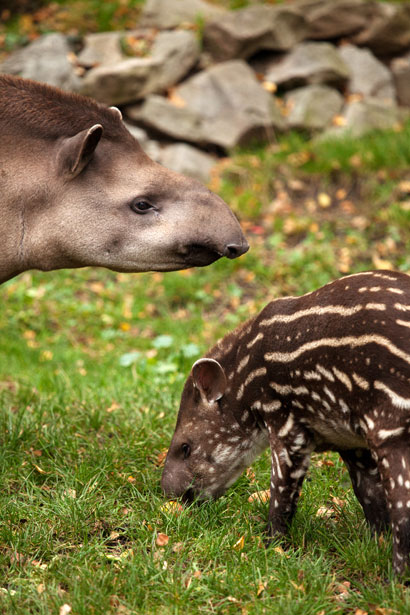
These rare mammals are often confused with hippos, pigs, or anteaters, but their closest living relatives are rhinos and horses. Tapirs are a living fossil; they’ve been around since the Eocene, having survived waves of extinction of other animals. They are South America’s largest native land mammal, with adults ranging from 300-700 pounds.
A Tapir’s most notable feature is its unique prehensile nose. Not only can they wiggle their nose, but they can use it to grab leaves when foraging. When swimming, they can use it as a snorkel! They are fast and agile swimmers. Tapir hides are tough, and their bodies are streamlined for easy maneuvering in the forest. They have four toes on their front feet and three on their hind feet, with which they can run very fast for short bursts of speed through the forest.
Tapirs don’t reproduce rapidly like some mammals; their pregnancies are very long – 13 to 14 months! And they only have one baby per pregnancy. Tapir babies stay with their mothers for twelve to 18 months. Though they are tough, resilient animals who have survived for many millennia, as their populations continue to decline, it is increasingly difficult for them to recover.
There are four living species of tapir, each with a distinct appearance and habitat range. Tapirs are found in Central and South America and Southeast Asia forests. They are becoming rare in their habitats, primarily due to habitat destruction and poaching, and they are designated as either Vulnerable or Endangered as a result.
Species
Lowland Tapir (Tapirus terrestris):
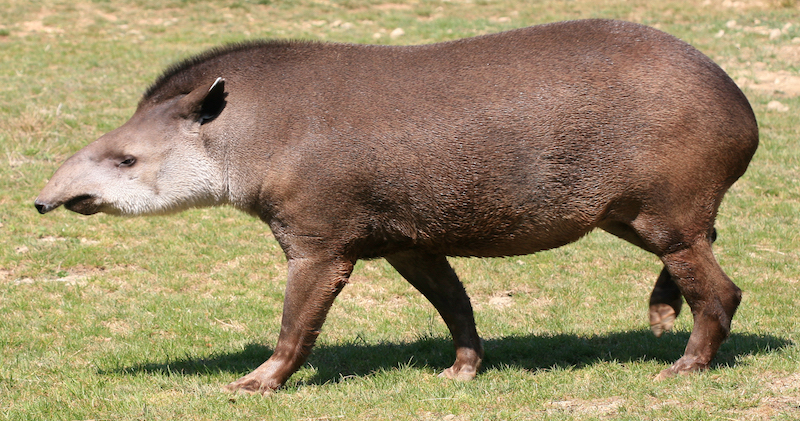
The Lowland Tapir is found throughout a wide geographic range, from North-Central Colombia to east of the Andes, including most of tropical South America. They occur primarily in tropical lowland rainforests, wetlands, and seasonally dry habitats such as the Chaco of Bolivia and Paraguay.
Baird’s Tapir (Tapirus bairdii):
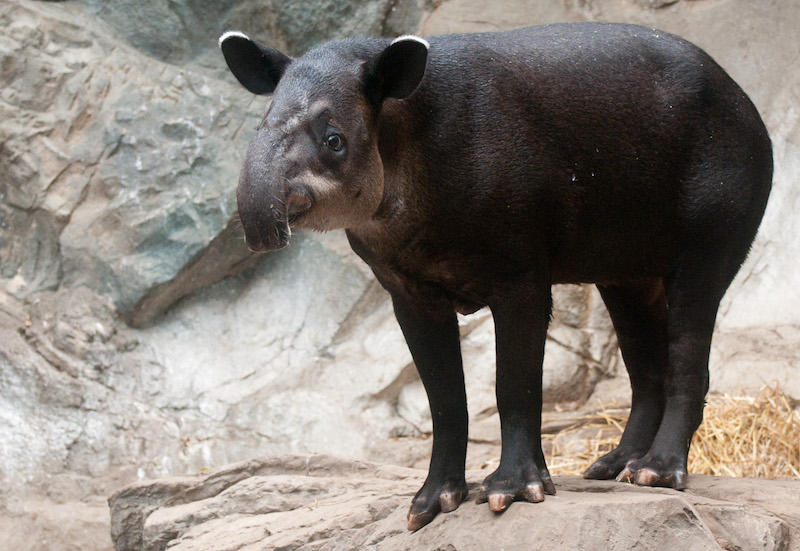
The Baird’s tapir is found in Oaxaca Province in Mexico through parts of Central America, including the western side of the Andean mountain range in Colombia (the Darien). Baird’s tapirs live in rainforests, lower montane forests, deciduous forests, flooded grasslands, and marsh areas.
Mountain Tapir (Tapirus pinchaque):
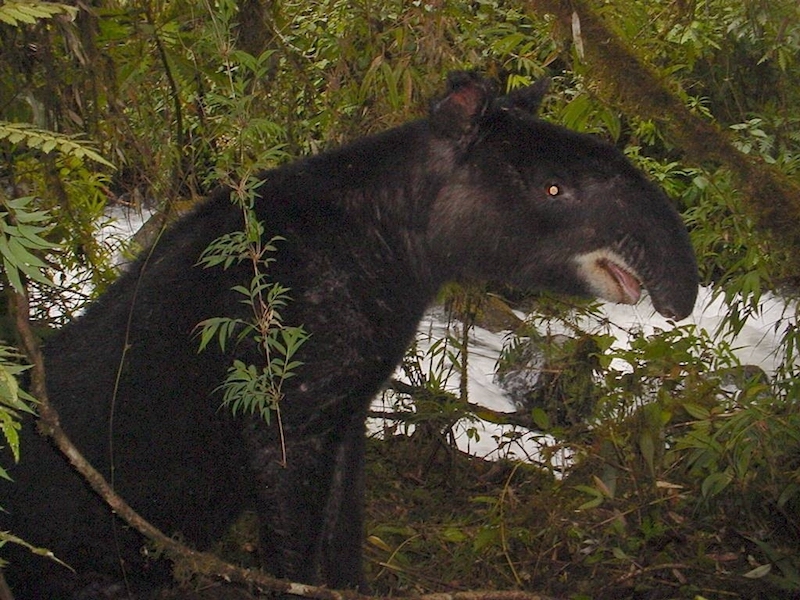
Mountain tapirs are found in Colombia, Ecuador, and northern Peru. Their habitat is montane forests, “paramos,” or high, treeless plateaus, and “cloud forests,” a wet, tropical mountain forest almost constantly covered by clouds. Mountain tapirs are found between 2000 and 4000 meters in elevation.
Malayan Tapir (Tapirus indicus):
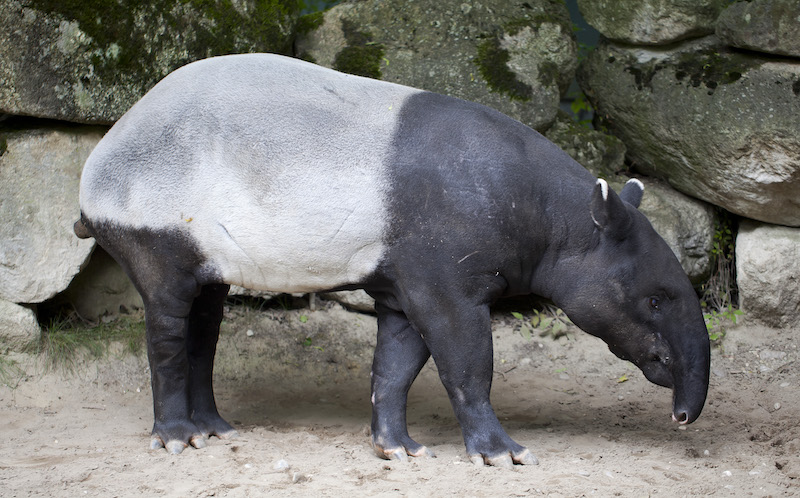
Malayan Tapirs are found in southern Thailand and southern Myanmar (Burma) through the Malayan Peninsula and on the Indonesian island of Sumatra. Their habitat is rainforests and lower montane forests. They can inhabit secondary, regenerating native forests.
Threats to their survival.
Three significant threats to the tapir include:
- Being hunted for their meat
- Habitats are becoming fragmented due to roads and farming
- Encroachment into protected park areas by subsistence farmers and illegal logging
Tapirs do well where few threats impede their everyday needs to thrive in large, undisturbed tracts of habitat. Certain areas of the Brazilian Amazon, Brazilian Pantanal, Peruvian Amazon, Honduran Mosquitia, and Panamanian Darien forests have healthy tapir populations.
Tapirs in the wild have predators, typically large cats, though this effect on their population is tiny compared to human predation and habitat consumption. Tapir young are born with a beautiful “watermelon” striped pattern on their hide, camouflaging them effectively from predators. Adults are skilled at running through thickets of forest and diving into rivers or deep pools of water to escape predators. Like all herbivores, they serve a role in the ecosystem by being a food source for predators.
Tapirs Play a Critical Role in Their Ecosystems
Tapirs shape and maintain the biodiversity of tropical ecosystems; without them, there would not be the same rich variety of animals and plants there. They are known as an “umbrella species” because they have a wide-ranging habitat, including wild cats, monkeys, deer, and many birds and reptiles. If we protect their habitat, the habitat of many other animals is also covered.
Tapirs are helpful to their native landscape in many ways; one role is that of seed dispersers. Tapirs eat various seasonal fruits; when mango or fig trees come into season, tapirs can often be found underneath these trees, eating the fruits that fall from them or are dropped by monkeys munching on fruit from above. The seeds of the fruits they eat are dispersed when they wander to a new location to deposit scat, and those seeds later sprout and grow new trees, helping the forest to regenerate. Because of the tapir’s enormous appetite for fruit, they have earned the title “gardeners of the forest.” Forest structure and diversity would be very different without the tapir in the landscape.
Because of their enormous size and extensive range, the tapir is one of the first species in its habitat to be adversely affected by human disturbance. Local extinction or population decrease may trigger adverse effects in the forest, causing disruptions of some vital ecological processes (e.g. seed predation and dispersal, nutrient recycling), eventually compromising the ecosystem’s long-term integrity and biodiversity. These factors added to the destruction of tapir habitat in recent years, justify the urgency for investigation of the status of the populations and the development and implementation of conservation and management plans.
Tapir Specialist Group advocates for tapirs and works to conserve their habitat and genetic diversity through research projects on tapirs, high standards of zoo husbandry, and networking with government bodies, conservation organizations, universities, and zoos to create greater tapir awareness and conservation planning.
What Tapir is found in Costa Rica?
The Baird’s Tapir (Tapirus bairdii).
Range:
The Tapir is an animal found mainly in moist, dense forests in the more temperate regions of the Southern Hemisphere. The Baird’s Tapir, the Spanish name Danta or Danto, can be found in the tropical forest of Costa Rica. This species of tapir is available from Mexico, Veracruz, and Ecuador. The Tapirs were common in Costa Rica, but for hunting, they are limited to the several national parks of Costa Rica, such as Santa Rosa National Park, La Selva, Cerro de la Muerte, Corcovado National Park, Penas Blancas National Park, Santa Elena Cloud Forest Reserve, and Monteverde Cloud Forest Reserve.
Size:
An adult Tapir can get a height at the shoulder of 29 to 42 in (74 to 107 cm)
Weight:
The Tapir is weighing 227 to 363 kg (500 to 800 lbs)
Diet:
The tapir has an herbivore diet and spends most of their time browsing to eat. The tapir eats leaves, branches, buds, twigs, shoots, seeds, berries, aquatic plants and fruit.
Average life span: The average life span of a tapir is about 25 or 30 years.
Habitat:
The tapir is found mainly in moist, dense forests, swaps, and in the high temperate forests of northern and south America. It continues to exist in dry, humid forest and steamy evergreen wooded area and have other habitats. They are active at night and pass their days resting in the middle of thick vegetation. The tapir was common in all types of habitats throughout Costa Rica. Now, they can be found in national parks. A medium number reside in Santa Rosa National Park, and many are available in Corcovado National Park and several other national parks.
Breeding/Reproduction:
Breeding: Tapirs do not have any particular breeding season. Female Tapir have a gestation period of around 390 days; most of the time, they have a single baby. The baby always follows the mother within a few minutes after the birth. All newborn tapirs have reddish-brown skin spotted with white spots and stripes. This pattern helps to provide the young one with excellent camouflage. The baby ‘freezes’ and becomes part of its background whenever there is danger lurking nearby. These coat markings last until six months old and disappear as the young tapir gets their adult coat. The youngster always remains with their mothers for almost a year and then leaves for their own life.
